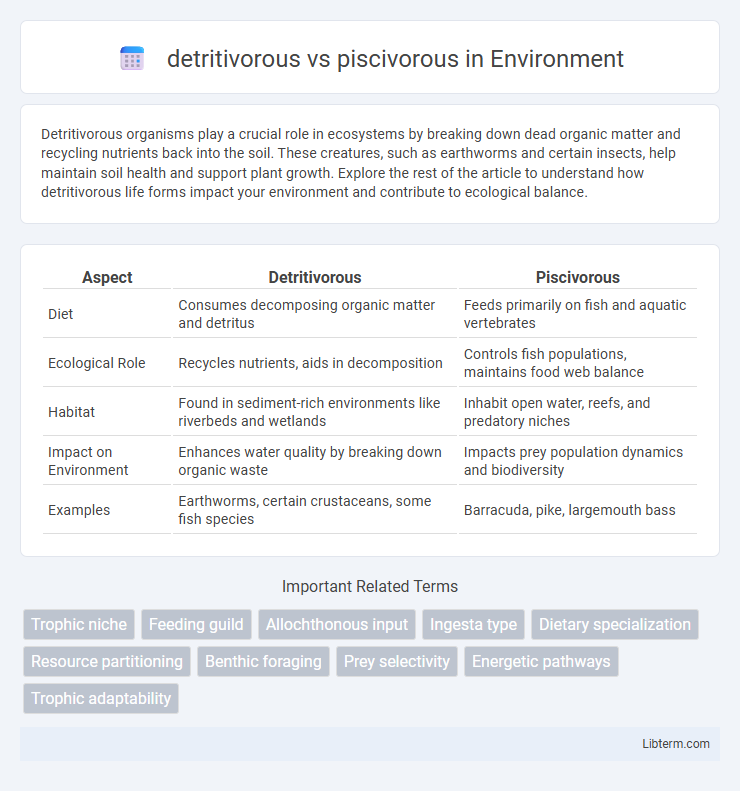Detritivorous organisms play a crucial role in ecosystems by breaking down dead organic matter and recycling nutrients back into the soil. These creatures, such as earthworms and certain insects, help maintain soil health and support plant growth. Explore the rest of the article to understand how detritivorous life forms impact your environment and contribute to ecological balance.
Table of Comparison
| Aspect | Detritivorous | Piscivorous |
|---|---|---|
| Diet | Consumes decomposing organic matter and detritus | Feeds primarily on fish and aquatic vertebrates |
| Ecological Role | Recycles nutrients, aids in decomposition | Controls fish populations, maintains food web balance |
| Habitat | Found in sediment-rich environments like riverbeds and wetlands | Inhabit open water, reefs, and predatory niches |
| Impact on Environment | Enhances water quality by breaking down organic waste | Impacts prey population dynamics and biodiversity |
| Examples | Earthworms, certain crustaceans, some fish species | Barracuda, pike, largemouth bass |
Introduction to Detritivorous and Piscivorous Feeding Strategies
Detritivorous feeding strategies involve organisms consuming decomposed organic matter and dead plant or animal material, playing a crucial role in nutrient recycling within ecosystems. Piscivorous species specialize in preying on fish, often exhibiting adaptations such as sharp teeth and enhanced hunting skills to capture mobile aquatic prey efficiently. Understanding these contrasting strategies highlights their ecological importance in energy flow and food web dynamics in aquatic and terrestrial habitats.
Definition and Core Characteristics
Detritivorous organisms consume decomposing organic matter, playing a vital role in nutrient recycling within ecosystems by breaking down dead plant and animal material. Piscivorous animals primarily feed on fish, exhibiting adaptations such as sharp teeth and keen eyesight to effectively hunt aquatic prey. Both feeding strategies are essential for maintaining ecological balance, with detritivores facilitating decomposition and piscivores regulating fish populations.
Digestive Systems: Adaptations for Different Diets
Detritivorous animals possess elongated intestines and specialized gut flora to break down decaying organic matter and extract nutrients efficiently. Piscivorous species have shorter, highly acidic digestive tracts with strong stomach muscles to rapidly process protein-rich fish prey. These digestive adaptations reflect evolutionary optimization for maximizing nutrient absorption based on the dietary composition of detritus versus live fish.
Habitat Preferences and Distribution
Detritivorous species predominantly inhabit benthic environments rich in organic matter, such as muddy riverbeds, estuaries, and floodplains where decomposing plant and animal material is abundant. Piscivorous species are commonly found in clearer, open waters like lakes, large rivers, and coastal marine zones, optimizing their hunting of fish prey within structured habitats such as reefs or submerged vegetation. Geographic distribution of detritivores often overlaps with nutrient-rich, sediment-laden waters, whereas piscivores occupy broader ranges influenced by prey availability and water clarity.
Role in the Ecosystem: Nutrient Cycling vs. Trophic Dynamics
Detritivorous organisms play a crucial role in nutrient cycling by decomposing organic matter and releasing essential nutrients back into the ecosystem, supporting primary production and soil fertility. Piscivorous species influence trophic dynamics through predation, regulating fish populations and maintaining biodiversity within aquatic food webs. Both feeding strategies contribute to ecosystem stability, with detritivores enhancing nutrient availability and piscivores controlling energy flow across trophic levels.
Key Examples of Detritivorous and Piscivorous Species
Detritivorous species such as earthworms, sea cucumbers, and certain catfish play a vital role in nutrient recycling by consuming decomposing organic matter. Piscivorous species like great white sharks, barracudas, and kingfishers specialize in preying on other fish, maintaining the balance of aquatic ecosystems. These feeding strategies highlight the essential ecological functions and specialized adaptations of detritivores and piscivores across terrestrial and marine environments.
Evolutionary Significance and Divergence
Detritivorous and piscivorous feeding strategies represent significant evolutionary adaptations that reflect divergent ecological niches and resource utilization. Detritivorous species evolved to exploit decomposing organic matter, promoting nutrient recycling and supporting ecosystem stability, while piscivorous species developed specialized predatory traits for hunting fish, driving morphological diversification and trophic dynamics. This divergence underscores the evolutionary pressures shaping feeding behaviors, morphological specialization, and habitat partitioning among aquatic organisms.
Energy Acquisition and Food Chain Position
Detritivorous organisms obtain energy by consuming decomposing organic matter, recycling nutrients within ecosystems and occupying a lower trophic level in the food chain. Piscivorous species acquire energy through predation on fish, positioning themselves higher as secondary or tertiary consumers with greater energy transfer efficiency from prey to predator. Differences in energy acquisition methods influence their ecological roles and nutrient cycling, impacting overall food web dynamics.
Environmental Impacts and Human Influence
Detritivorous species play a crucial role in aquatic ecosystems by breaking down organic matter and recycling nutrients, which helps maintain water quality and supports biodiversity, while piscivorous species influence fish population dynamics through predation, affecting food web stability. Human activities like pollution, habitat destruction, and overfishing disrupt detritivore habitats and reduce piscivore prey availability, leading to imbalanced ecosystems and compromised fisheries. Conservation efforts must address these impacts by protecting habitats, regulating fishing practices, and mitigating pollution to sustain ecological functions provided by both detritivorous and piscivorous organisms.
Conclusion: Comparing Detritivorous and Piscivorous Ecological Roles
Detritivorous species play a crucial role in nutrient cycling by breaking down organic matter and recycling essential elements within ecosystems. Piscivorous species regulate fish populations, maintaining trophic balance and promoting biodiversity through predator-prey dynamics. The complementary functions of detritivores and piscivores underpin ecosystem stability and energy flow, highlighting their indispensable roles in aquatic and terrestrial habitats.
detritivorous Infographic

 libterm.com
libterm.com